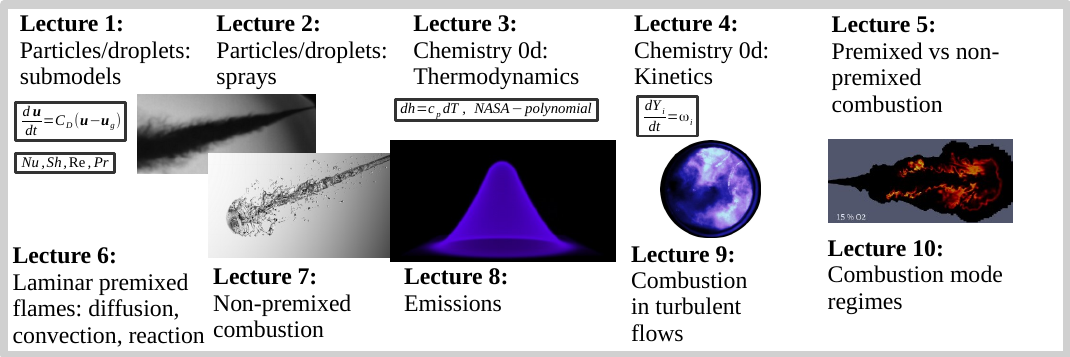AAE-E3030 - Numerical Modeling of Multiphase Flows D, Lecture, 28.2.2022-2.6.2022
Kurssiasetusten perusteella kurssi on päättynyt 02.06.2022 Etsi kursseja: AAE-E3030
Osion kuvaus
-
How to complete the course ?
The course is completed by solving 5 homework assignments with computational/practical focus. The assignments are returned approximately every 2 weeks. You can gain additional 0.5 grade unit bonus - based on self-evaluation at end of the course - by attending discussion in the general discussion forum by raising questions or providing answers.

Why numerical modelling of multiphase flows ?
The course supports both computational and experimental career pathways in applied sciences. Multiphase flows occur in energy applications, combustion systems, atmospheric flows, hydrodynamical applications, heat transfer design, medical applications and so on. In broad sense, multiphase flow can refer to any flow where several fluid phases (e.g. two different gases or gas/liquid mixture) with or without chemical reactions is present. Particle/droplet laden flows or bubbly flows are classical examples of multiphase flows. Such flows typically involve various submodels for e.g. particle transport, chemical reactions, mixing, droplet evaporation or breakup. Awareness of such models gives various career opportunities to work with software utilizing such models. The course is a logical continuation of the following courses: Computational Fluid Dynamics, Heat Transfer, Combustion Technology. However, the course can also been taken as a stand-alone course. Companies such as Fortum, Neste, Oilon, Wärtsilä, Andritz, Valmet, Wärtsilä, Meyer, ABB, GE etc have indicated strong interest in the topic of the course in their R&D. There is a strong demand to build expertise in numerical modelling. On the course, we mostly use Matlab, Python, and Cantera.
Intended learning objectives:
ILO1 - Particles and droplets: Student can apply and implement most common particle/droplet/bubble sub-models (transport, heat transfer, evaporation, break-up) in Matlab environment.
ILO2 - Transport mechanisms and governing equations: Student understands the role of mixing and diffusive transport in fluid dynamics with flame propagation as an example. Student understands the governing equations of compressible and reacting flows and how certain common sub-models are linked to the governing equations.
ILO3 - Chemistry 0d: Student can apply the Cantera software to evaluate 0d methane oxidation (i.e. ignition) by completing various parameter sweeps. The student can estimate emission levels from such simulations. The student can carry out thermodynamics calculations on basic oxidation processes.
ILO4 - Chemistry 1d: Student can estimate premixed flame speed using the Cantera software. The student understands different sources of uncertainity in chemistry modeling.
ILO5 - Premixed and non-premixed combustion: The student understands the difference between premixed and non-premixed combustion. Student can analyse Bunsen flame development using a provided Matlab code.
Acknowledgement: Figures on this page are courtesy of H.Kahila, A.Wehrfritz, A.Artman, Z.Ahmed, and H.Hillamo.
